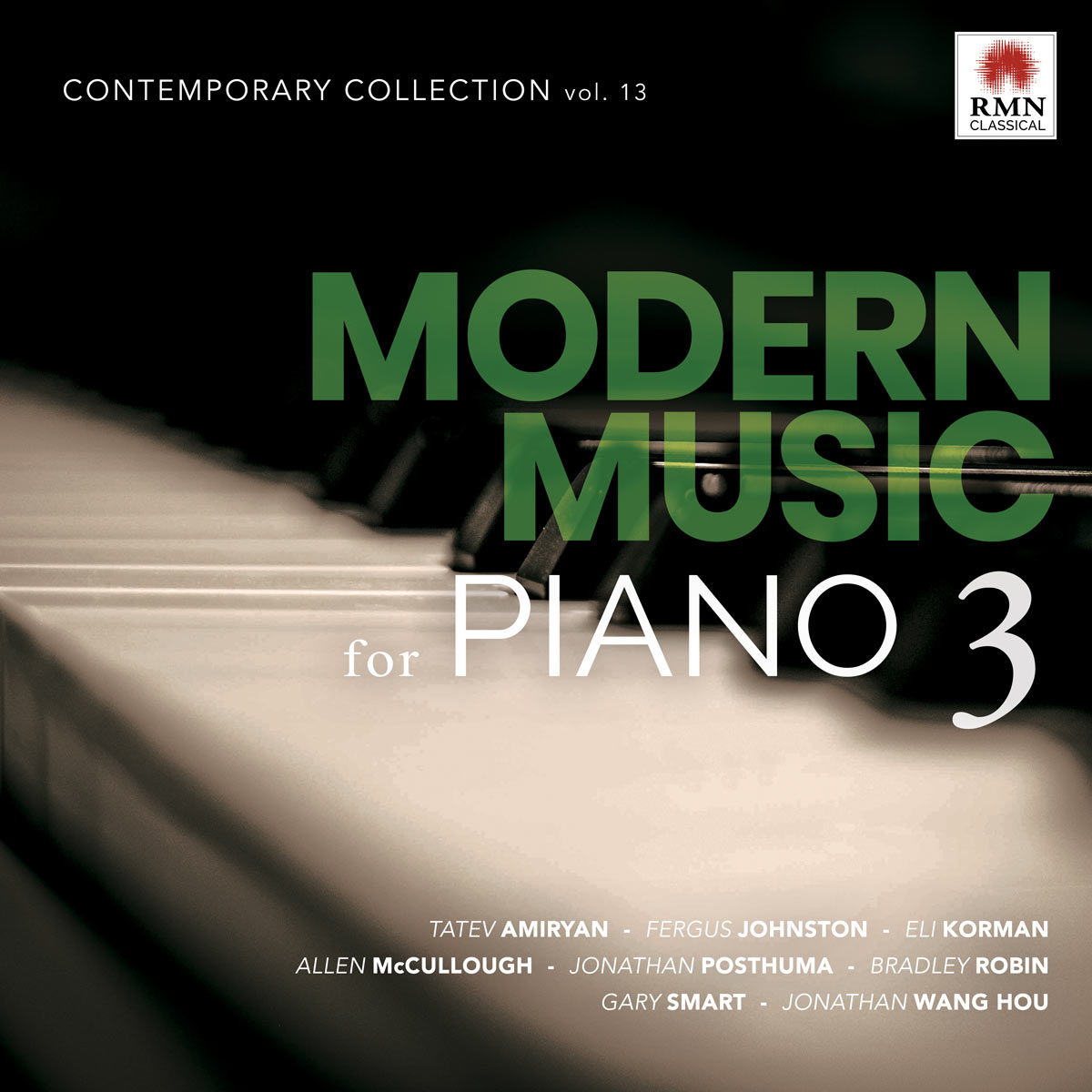MUSIC > Modern Music for Piano 3

FULL ALBUM
Title: Modern Music for Piano 3
Release Date: 30 Apr 2021
Label: RMN Classical
Produced by R. Romano
Cover design by RMN Classical
Performed by
(in order of playlist)
01. Xander Benham
02. Izumi Kimura
03. Yukino Miyake
04. Yukino Miyake
05. Yukino Miyake
06. Yukino Miyake
07. Hayk Melikyan
08. Bradley Robin
09. David Henry
10. Amit Dolberg
11. Jonathan Wang Hou
12. Jonathan Wang Hou
Modern Music for Piano 3 by Various Artists
| N. | Play | Title | Composer | Time |
| 01 | Hovering No. 12 from Paul Klee: Painted Songs | Jonathan Posthuma | 03:21 | |
| 02 | The Oul’ Winda Rag | Fergus Johnston | 04:55 | |
| 03 | Piano Sonata no.1: I. Kimnara’s Blessing | Gary Smart | 06:34 | |
| 04 | Piano Sonata no.1: II. Moonspinner | Gary Smart | 04:29 | |
| 05 | Piano Sonata no.1: III. Turtle Dreams of Flight | Gary Smart | 05:50 | |
| 06 | Piano Sonata no.1: IV. Chez Garuda | Gary Smart | 06:20 | |
| 07 | Berkano | Tatev Amiryan | 06:01 | |
| 08 | Spread | Bradley Robin | 07:45 | |
| 09 | Prelude 5 | Allen McCullough | 03:15 | |
| 10 | Tehuda | Eli Korman | 05:56 | |
| 11 | Ballade op. 10 No. 1 | Jonathan Wang Hou | 06:30 | |
| 12 | Ballade op. 10 No. 2 | Jonathan Wang Hou | 07:58 |
Paul Klee: Painted Songs is an ongoing series of instrumental chamber works inspired by the visual art of Paul Klee. The series began in 2011 as a composition assignment to which the composer added more works through the years.
In "Hoverings" Bold angled lines and colorful, multi-textured planes overlap and interconnect to create an illusion which appears to move while remaining fixed. An arrow near the top suggests this structure is suspended in air, or perhaps slowly rising. Fluid lines and accented figures trace downward and upward courses in free, toccata-like gestures. Harmonic, melodic and temporal ambiguity support this freely evolving structure that slowly rises out of view.
An oul’ winda rag (or “old window rag”) is a cloth device used by Dubliners to clean the
windows of their homes. The Guardian Dublin International Piano Competition commissioned the piece to the composer as a test piece for semi-finalists in the 1997 competition, and, since
piano competitions often have the window-dressing of contemporary pieces set as part of the competition, the composer celebrate this in the title, which is also an anagram of “The Guardian Owl”, the symbol of the company which sponsored the event. Their phone number (282820, or “tu whit
tu whit tu whu” (the sound an owl makes) in their ad campaign) is ciphered to generate the
harmonic and melodic material in the piece which occurs at several speeds, often
overlapping, so the piece becomes a rag-time of sorts.
Completed in 2005, this large, four-movement work was written by the composer over the course of almost five years. This sonata is pluralistic in nature, as it utilizes several disparate styles as source material. Using composer's words "My goal was to pay homage to the musical traditions I love, to find a unity in diversity."
The sonata opens with Kimnara’s Blessing, which combines elements of Balinese gamelan music with elements of the Western European 19th century romantic tradition. The movement is set in a free sonata-allegro form. Kimnara is one of several musical gods in the Hindu-Buddhist canon.
Moonspinner is named after a handcrafted wooden toy the composer saw once in North Carolina. This scherzo like movement celebrates American folk music. A brilliant abstract fiddle music alternates with an original “folk tune” to create a simple rondo format.
The third movement, Turtle Dreams of Flight, explores the far extremes of tempo and range available in musical expression. Here very slow, low music gradually transcends to very fast, high music and back again, with some odd dream-like episodes along the way.
The work closes with Chez Garuda, a musical portrait of the imposing Hindu bird-man- god. This jazz-influenced movement is set in sonata-allegro form. Possessed by a passionate urgency, Garuda music alights to rest only a couple of times, otherwise it whirls with a fierce activity that spins to the final climax.
In this recording pianist Yukino Miyake performs the sonata with a wonderful musicality and brilliant virtuosity.
The sonata opens with Kimnara’s Blessing, which combines elements of Balinese gamelan music with elements of the Western European 19th century romantic tradition. The movement is set in a free sonata-allegro form. Kimnara is one of several musical gods in the Hindu-Buddhist canon.
Moonspinner is named after a handcrafted wooden toy the composer saw once in North Carolina. This scherzo like movement celebrates American folk music. A brilliant abstract fiddle music alternates with an original “folk tune” to create a simple rondo format.
The third movement, Turtle Dreams of Flight, explores the far extremes of tempo and range available in musical expression. Here very slow, low music gradually transcends to very fast, high music and back again, with some odd dream-like episodes along the way.
The work closes with Chez Garuda, a musical portrait of the imposing Hindu bird-man- god. This jazz-influenced movement is set in sonata-allegro form. Possessed by a passionate urgency, Garuda music alights to rest only a couple of times, otherwise it whirls with a fierce activity that spins to the final climax.
In this recording pianist Yukino Miyake performs the sonata with a wonderful musicality and brilliant virtuosity.
The work pays tribute in its concept and title to "Berkano" or 'Berkanan' the reconstructed Proto-Germanic name of the b rune ᛒ, meaning "birch." It is associated with healing birch tree, the first tree to awaken in the spring time. Thus Berkano rune is about the cycle of birth, death, and rebirth. It symbolizes new beginnings, renewal, recovery, healing, and life changes, physical and spiritual birth and rebirth, fertility and growth, motherhood, and sacral wisdom.
"Spread" is the culmination of a long process of compositional exploration for the composer. Much of the material was created through algorithms guided by intuition to meet aesthetic goals in the compositional process, specifically the vertical expansion or compression of harmonic and rhythmic materials, with the goal to create an organic flow. Harnessing tension, release, and subtle, nuanced changes of emotional tones, Spread represents the first movement in a series of envisioned works manipulating harmonic material in similar ways.
In Prelude No.5, the composer challenged himself to think in terms of homophony, instead of a more polyphonic style, with the piece unfolding as a harmonization of the descending, chromatic scale. With melody playing a prominent role atop the chordal structure in the opening section, a contrasting “B” section pays homage to Liszt’s variations on Bach’s Cantata Weinen, Klagen, Sorgen, Zagen (Weeping, Lamenting, Worrying, Fearing), with an intentional use of tonal harmony, followed by a re-orchestrated and extra-grandiose reprise of the “A” section. Perhaps the end of the prelude “laments” the end of the tonal era itself, with the “B” section returning once more with a sense of poignant solemnity. The combined major/minor harmony that ends the work, however, represents a “tip of the hat” – and “tip of the iceberg” – toward the extraordinary possibilities explored in the post-tonal world.
The piece originates from the idea of exploring the piano’s biggest characteristic, its’ resonance. The piano’s resonating enclosure enables the notes giving them time to breathe, resonate and fill the space of the instrument. To achieve its sonic result the piece make use of sustain pedal, electric bows, resonating clusters, and quick phrases in which the sustain pedal is inserted - thus creating a cluster once more. Harmonically, the composer explores the differences between how chords in open position and close position resonate. The electric bows maintain a major second interval between the notes A and B, and act also as a link between the different materials and sections in the piece. They are effectively the embodiment of the piano’s resonance - they cause the strings to vibrate. The composer discovered that every time the pianist releases the sustain the electric bows stops playing, and when the sustain pedal is pressed once more the electric bows seem to creep in, thus creating a small crescendo. The performer’s only way of activating the electric bows is to make their string available for vibration, either by using the sustain pedal or by pressing the notes A and B themselves. In addition, the electric bows provide closure to the cycle of the piece - it ends the same way in which it began.
“Tehuda” (resonance) begins with a very strong and grotesque material, and slowly breaks it down into an abstract substance.
Written in August 2020 as a graduation gift for a friend, the Ballades Nr. 1 and Nr. 2 were respectively inspired by a night of thunderstorms, which started the California wildfires of the same year, and a sunset, fervidly dappled by the haze of ensuing smoke.
Using the composer's words "the natural landscape of my home state bears a great influence on my work: whether it be the snowcapped, alpine Sierras; the chaparral coastline, shrouded in fog and mists; the cascading cliffs of Yosemite; or the valley woodlands, peppered with titanic trees."
To pay tribute to these myriad wonders, a total of $671 was raised by the composer during the first 48 hours following the online premier of his performance of the work, in association with the California Community Foundation’s Wildfire Relief Fund; outlying contributions were also made toward the Recovery Fund managed by the California Department of Parks and Recreation for the restoration of Big Basin State Park, as well as to combat COVID-19 outbreaks in communities displaced by the fires.
Using the composer's words "the natural landscape of my home state bears a great influence on my work: whether it be the snowcapped, alpine Sierras; the chaparral coastline, shrouded in fog and mists; the cascading cliffs of Yosemite; or the valley woodlands, peppered with titanic trees."
To pay tribute to these myriad wonders, a total of $671 was raised by the composer during the first 48 hours following the online premier of his performance of the work, in association with the California Community Foundation’s Wildfire Relief Fund; outlying contributions were also made toward the Recovery Fund managed by the California Department of Parks and Recreation for the restoration of Big Basin State Park, as well as to combat COVID-19 outbreaks in communities displaced by the fires.

